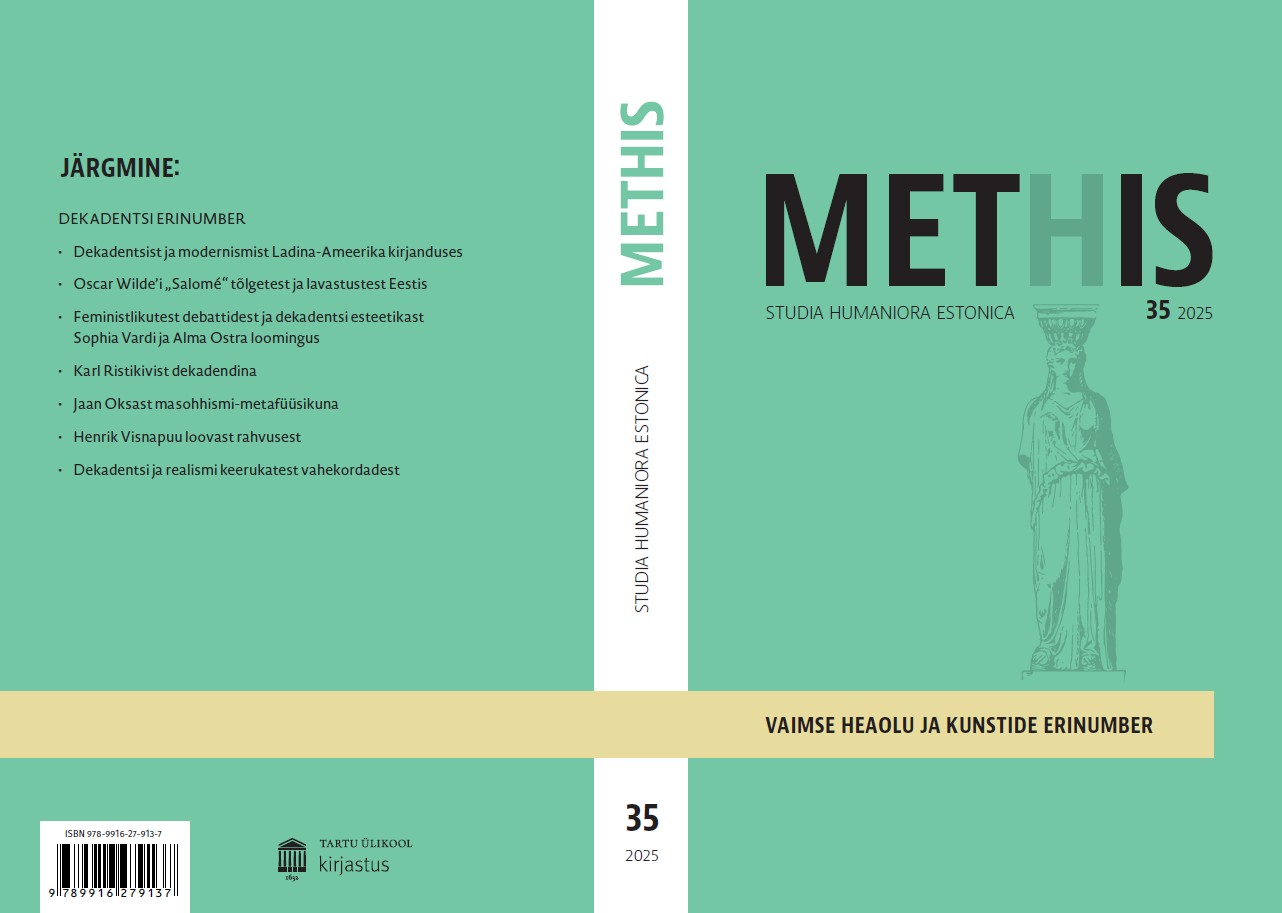Rahvuskultuurilisest enesemääratlemisest eesti kirjandusloos. Igor Severjanini hübriididentiteedi peegeldus luulekogus „Klassikalised roosid“ (1931) / National-cultural Self-identification in Estonian Literary History: Igor Severyanin’s Classical Roses...
DOI:
https://doi.org/10.7592/methis.v28i35.25578Keywords:
hübriididentiteet, Igor Severjanin, eesti kirjandus, pagulaskirjandus, kultuuriline kuuluvus, hybrid identity, Estonian literature, diasporic literature, cultural engagementAbstract
Teesid: Artikkel käsitleb, kuidas vene luuletaja Igor Severjanini (1887–1941) Eesti-perioodi luule – eeskätt kogu „Klassikalised roosid“ (1931) – peegeldab hübriidset kultuurilist identiteeti, mis kujunes pikaajalise kokkupuute kaudu Eesti kultuuriruumi ja ühiskonnaga. Kuigi Severjanin jätkas kirjutamist vene keeles, ilmutab tema tähelepanu Eesti maastikele, ühiskonnale ja isiklikele paguluskogemustele kahetist kuuluvustunnet. Tuginedes identiteediteooriatele (Giddens, Bhabha), väidab artikkel, et Severjanin tegutses kultuuridevahelises „kolmandas ruumis“. Tema näitel saab vaadelda, kuidas Eesti kirjandus võib hõlmata ka autoreid, kes kirjutavad teises keeles, kuid suhestuvad sügavalt siinse kultuurilise ja ühiskondliku kontekstiga.
National-cultural Self-identification in Estonian Literary History: Igor Severyanin’s Classical Roses (1931) as a Reflection of Hybrid Identity
This article presents an analysis of how Igor Severyanin’s (1887–1941) Estonian-period poetry, especially the 1931 collection Classical Roses, reflects a hybrid cultural identity shaped through long-term engagement with Estonian society. Although Severyanin continued to write in Russian, his sustained presence in Estonia, thematic focus, and cultural participation invite us to view his work within Estonian literary history.
Migration – whether voluntary or forced – often initiates redefinition of personal and artistic identity. It challenges not only the writer’s linguistic choices, but also the ways in which they position themselves within multiple cultural frameworks. The article draws parallels with Estonian exile writers like Marie Under and Ilmar Laaban, who represent two poles: one retaining a monolingual cultural identity, the other developing a dual literary presence in exile. These cases frame the discussion of how identities are preserved, reshaped, or extended in diaspora. Such comparisons underscore how cultural belonging is not a fixed essence, but an ongoing negotiation between internal continuity and external change.
The theoretical basis draws on Fromm, Erikson, Hall, and particularly Giddens, who sees identity as a reflexive, evolving narrative. Additionally, Bhabha’s concept of the ‘third space’ provides a model for understanding hybrid identity as a space of cultural fusion and negotiation, where individuals draw from multiple traditions to form something new. The third space resists binary opposition and creates the possibility for a productive in-between, where identity is constructed relationally rather than absolutely.
A central distinction is drawn between multiple identity and hybrid identity. Multiple identity refers to the coexistence of various roles within one person, such as gender, profession, and nationality and is a common condition. Hybrid identity, in contrast, describes a synthesis of cultural identities where the elements influence and transform one another. To clarify the difference, the article uses two metaphors: a picnic basket and a hybrid car. A picnic basket holds diverse items side by side symbolising the layered but separate nature of multiple identity. A hybrid car, however, alternates or combines different energy sources mirroring how hybrid identity draws on more than one culture as active creative forces. The latter metaphor captures the dynamism of cultural interplay, where each identity component reshapes the whole rather than remaining static.
Estonian literary history contains figures who have embodied these modes. Lydia Koidula, Marie Under, and Ilmar Laaban each navigated multilingual and multicultural environments in distinct ways. These examples reveal that national literature has often developed through contact, translation and reinterpretation rather than in isolation. Severyanin, while never switching from Russian, developed a second literary orientation rooted in Estonia’s nature, language milieu, and cultural networks.
His poetry collection Classical Roses exemplifies this transformation. Structured into thematic sections, it gives weight to both Russia and Estonia. These sections are not in conflict, rather, they reflect parallel emotional and cultural investments. Severyanin praises and criticises both lands, revealing layered and evolving affiliations. His detailed descriptions of Estonian landscapes, rural life, and local people show more than surface fascination, they reflect lived experience and a sense of belonging.
Notably, the book includes a personal statement declaring Toila as his permanent address from 1918, a gesture that reinforces his rootedness in Estonia. Although he continued to write in Russian, the subjects of his poetry increasingly reflected his new context. Themes such as nature, exile, and everyday life reveal Severyanin’s negotiation of his place between two cultural homes. His stylistic shift toward clarity and sincerity during the Estonian period further supports this realignment of poetic identity.
The article challenges narrow, language-based definitions of literary canonicity. It argues that cultural engagement, in addition to language, should be a criterion for literary inclusion. Writers who embed themselves in the life, landscape, and discourse of a place may rightfully be considered part of its literature, even if they write in another tongue. Severyanin’s case demonstrates how such inclusion can be argued on thematic, contextual, and existential grounds. This reframing allows literary history to become more representative of the cultural complexities of real lives.
In conclusion, Classical Roses can be read as a poetic document of hybrid identity, a record of dual belonging shaped by biography, geography, and artistic vision. The collection reflects Giddens’ idea of selfhood as a narrative project and Bhabha’s notion of a cultural third space. Severyanin’s continued connection to Russia, alongside his deep investment in Estonia, results in a dual identity that is not merely layered, but fused.
This perspective supports a more inclusive understanding of literary history that acknowledges hybridity, migration, and intercultural dialogue as fundamental elements in modern literature. Severyanin’s work, situated between cultures, helps expand the boundaries of what Estonian literature can be.


